


 |
November 17, 2009: Zihuatanejo, Mexico |
 |
November 15, 2009: Hualtulco, Mexico |
 |
Return to the Index for Our Panama Canal Cruise |
Arriving at Acapulco, Mexico
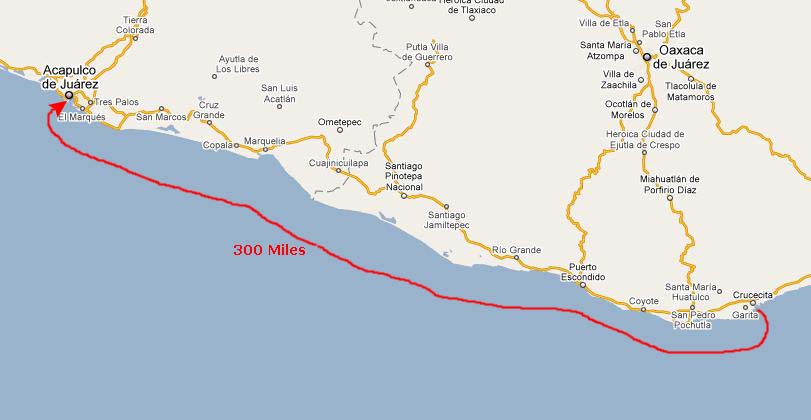
|
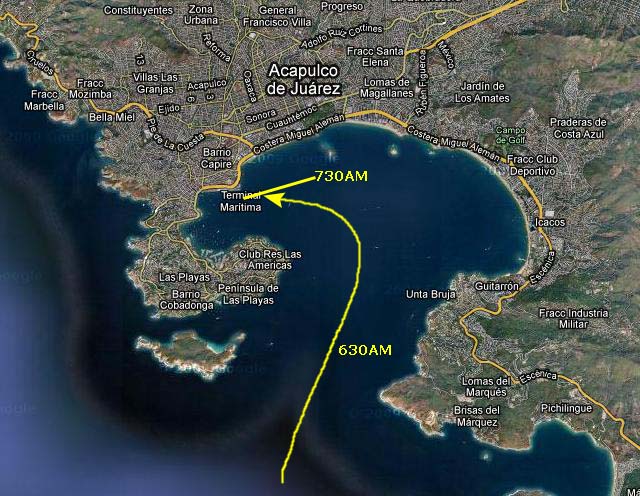
|
I was up early to watch the docking procedure; I was on the Observation Deck at about 6AM, when the coastline first began to take shape in the dim light. A half hour later we were in the bay itself.
Beginning with the sunrise (which occurred while we were navigating through the bay), I took a series of five pictures that will bring us into the dock at Acapulco. I've put some thumbnail images for these pictures below. If you will click on these thumbnails from left to right, you can see this series of photographs:

|
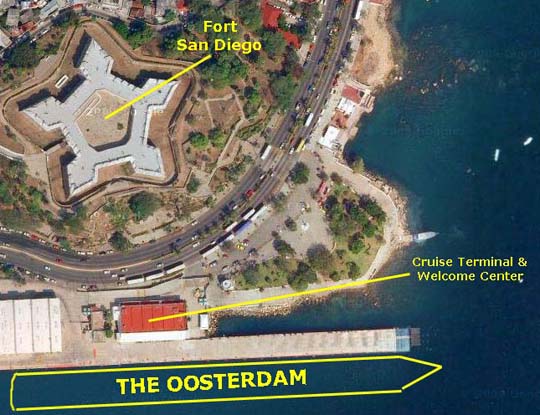
|
When we first booked our cruise, we had also booked a shore excursion to the Mayan ruins at Xochicalco, which is a 3-hour trip from Acapulco. The tour was to have taken all day, and we would have seen ruins like the ones in the picture below (taken by some other tourist from the entrance to the hilltop site):
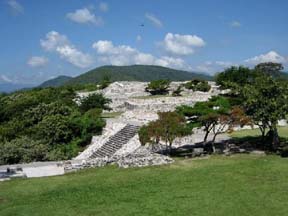
So now we had a free day in Acapulco; there were no other excursions that seemed interesting. Greg and Paul and Bud and Chet were planning to go try to find the house that Bud and Chet had lived in for a time when they were residents here many years ago, so Fred and I would just do some walking around to see what we could see.
After breakfast, we went up to the Observation Deck again. Now that the sun was completely up, Fred could get some really excellent pictures of Acapulco; the city almost surrounded the ship. If you will click on the thumbnail images below, you can see the best of these pictures:

|
Fred also put together two very nice panoramic pictures, and I'd like to include them here:
|
|
Walking Around Near the Ship
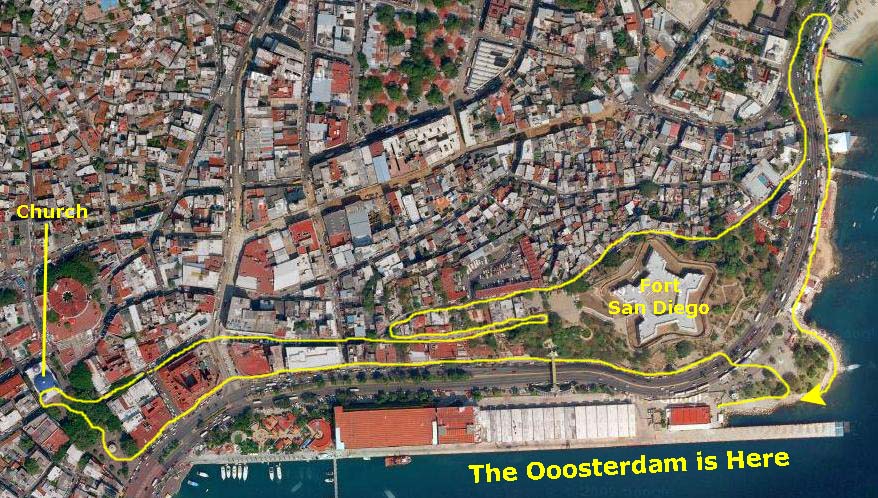
|
So we headed west instead along the main street, eventually coming to a small park, which we went into and through. At the other side was a church that we looked around. Then we doubled back east, going along the side street Jesus Carranza. We crossed a main street called Juan R. Escudero to Morelos Street and took that towards the Fort. I thought we might be able to just skirt the Fort, but the street dead-ended into a closed gate, so we had to double-back and take Hornitos Street instead to continue east. We followed that winding street over the hill and down towards the beach.
Once we got back to Miguel Aleman, we walked a little further east along the beach, just to see what it was like. Finally, we turned around and walked along the wide sidewalk back towards the ship. We took lots of pictures along the way, and I will try to deal with them in sections.
Ship to Fort San Diego
|
The Oosterdam in Acapulco Bay |
Fred walked ahead of me to the end of the pier to get a picture looking across the bay at the new Acapulco. When I joined up with him, I took a picture of Fred with Acapulco in the background, and you can see that picture here. We walked out of the park area by the ship and crossed the street to Fort San Diego. There was a stairway leading up to an entrance to the fort, but when we climbed the stairs the gate was closed and locked; Fort San Diego was also closed due to the holiday. That was a disappointment. We had to content ourselves with walking through the rock ledge garden between the street and the fort. Thwarted in our efforts to get inside For San Diego, we continued walking west along the main street, passing under a pedestrian bridge that led from the fort to the bay side of the street. I am not sure if the building it entered was just a garage or some sort of museum.
The Zocalo and Our Lady of Solitude
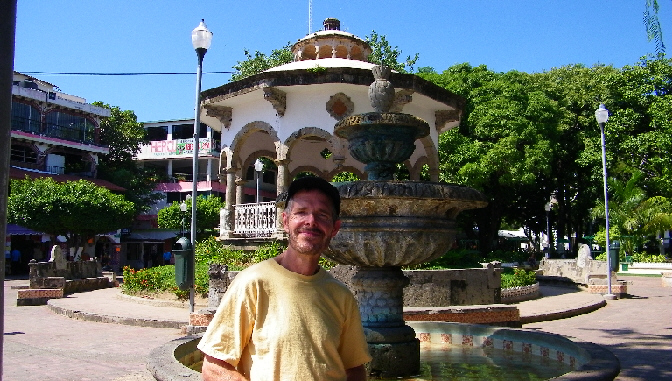
|
The zócalo is lined with ice cream stands and sidewalk cafes, and you can mingle with the locals as they go about their daily business- which, apparently, includes shoeshines. (I wondered about the reason for the patron to sit in the chair while the vendor takes the shoes off his feet and shines them on his knee; why not just leave them on the patron's feet?) The daily routine around the zócalo is pretty much the same as it has been for years.
There were also three fountains in the Zocalo, as well as two or three monuments, so there was a lot to take pictures of. If you would like to see more of the pictures we took here in the Zocalo, just click on the thumbnail images below:

|
|
When we were in the middle of the Zocalo, I made a movie looking all around at the surroundings. Use the player at left to to watch it. |
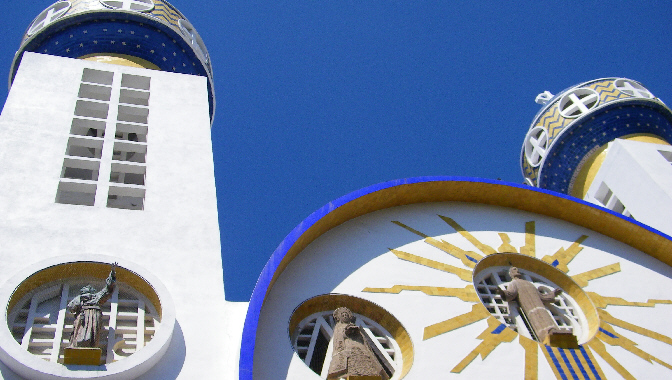
|
This church is a perfect example of Acapulco's rich history with Spanish, Moorish and native influences. Its distinctive sky blue domes dominate the downtown plaza. The inside of the dome is also painted blue with little angels all over the place, and there are interesting stained‑glass windows on either side of the chapel. Inside this cool and quiet church is a large collection of religious statues. Saturdays are a good day to peek in on local weddings and baptisms as these events are a window into Mexican life. Today there was some sort of service going on.
|
When we went into the church, I quietly took a movie of the service or ceremony that was going on inside. |
Walking Over the Hill to the Beach
|
|
After we crossed this street, we followed a narrow street up the hill towards Fort San Diego. At first, I thought the street might go around the Fort, but instead it dead-ended into the closed grounds, so we had to double-back down the hill a ways and take a street one block over. This street did go up to the crest of the hill, and here we got a good view our across Old Acapulco towards the hills to the northeast. There was one other interesting sight along this quiet semi-residential street- what looked like a local computer repair shop.
Along Acapulco Bay
One thing that there seemed to be a lot of right around here were pelicans. They were all over the place, dotting the beach, sitting on rocks or perching on some of the small boats that were floating just offshore. I'm not sure why there were so many; they certainly didn't seem concerned about all the people around. Fred took a number of good pictures walking along here, and even though I took some of the same views, mostly it was his that turned out better. If you'll click on the thumbnails below, you can see some of these interesting pictures:

|
|
|
There were some other interesting sights as we walked along. People were selling not only the fish they had caught, but also the shells they came in. Some of the restaurants along this stretch of beach had patios over the water, and some of these offered nice views across the bay.
After walking around for a while, we headed back up the street towards the ship, intending to go back on board, cool off for a while, and then go out on another walking tour to a different area of town. Just before reaching the small park that sits right outside the cruise terminal, we came across an interesting mermaid sculpture. I couldn't quite tell what it was supposed to represent.
Before we went back on board, Fred did another of his panoramic pictures:
|
On Board the Oosterdam (Daytime)
|
|
A Walk to El Mirador and the Cliff Divers
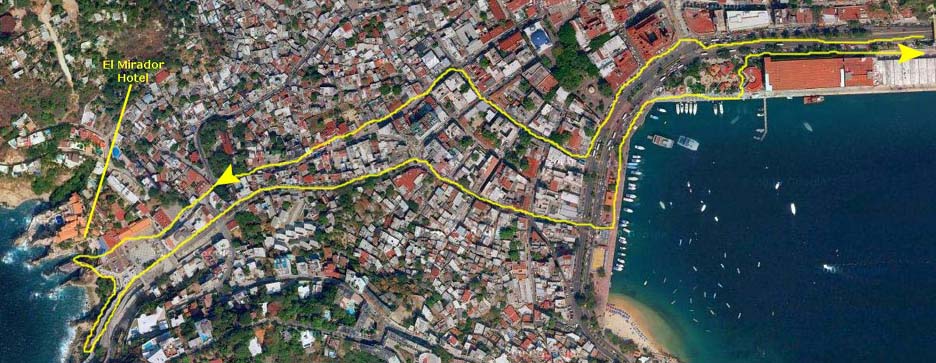
As you can see, we walked again along the main street near the ship heading west, but then followed the signs to "Mirador" and headed through the neighborhood side streets. After a bit of zig-zagging and about a thirty-minute walk, we came out at the plaza next to the hotel.

|
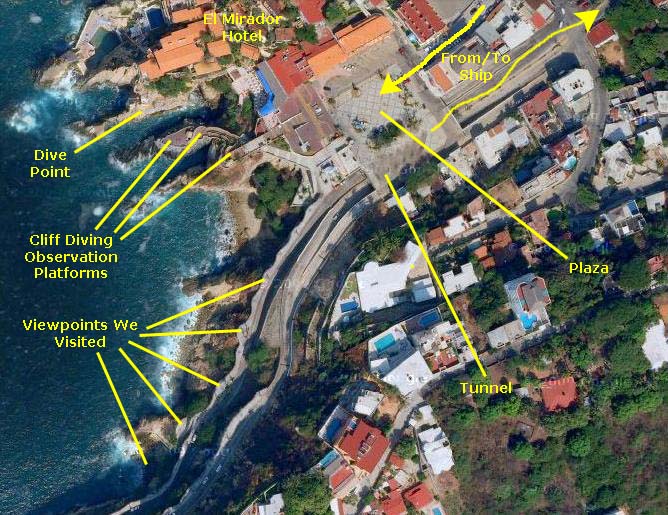
|
West of the plaza, there is a series of stairways leading down to the main viewing area for the cliff divers. The first thing we found out by reading some of the signs was that the divers put on their show early in the morning, at noon and, at this time of year, just at dusk. We had missed the first two of those times, and wouldn't be here long enough for the evening show. We also noted that when the diving is going on, there's an admission to these viewing areas but at this time we could wander up and down them for nothing.
Once we'd done that, then we walked a bit south to the walkway that is part of the cantilevered highway that comes out of a tunnel near the hotel and then winds around this point of land west of the city. We walked along that walkway until it ended, stopping at the various observation points and even climbing down to the rocky shore on occasion. Even though we didn't see any diving, we got some great pictures.
The Plaza at El Mirador
|
I made a movie here in the plaza at the top of the cliffs overlooking the Pacific, and you can see the hotel, the cliff diving area and the other observation areas we visited. |
The Hotel El Mirador
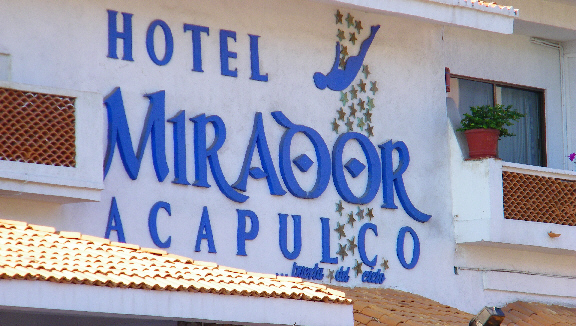
|
"Generations of visitors to Acapulco have enjoyed vacationing at the legendary Mirador Hotel. From their villa‑style rooms cut into the mountainside, they've succumbed to the spectacular dual vistas: the sparkling Pacific Ocean on one side and the tranquil beauty of Santa Lucia Bay on the other. Now it's your turn to visit the most photographed hotel in Mexico and marvel at the world famous La Quebrada diving show. Experience al fresco dining at La Perla restaurant and enjoy the gracious Mexican hospitality of the Mirador Hotel. The resort's traditional Mexican architecture is perfectly suited to its majestic location carved into La Mira Mountain. The Mirador Hotel offers a variety of daytime and evening dining choices, from snacks to multi-course meals, served during the cliff divers' performances. From relaxed terraced dining overlooking the Quebrada Cliffs to casual poolside cocktails, Mirador is designed to please every guest."

|
Cliff Diving Ravine & Observation Platforms
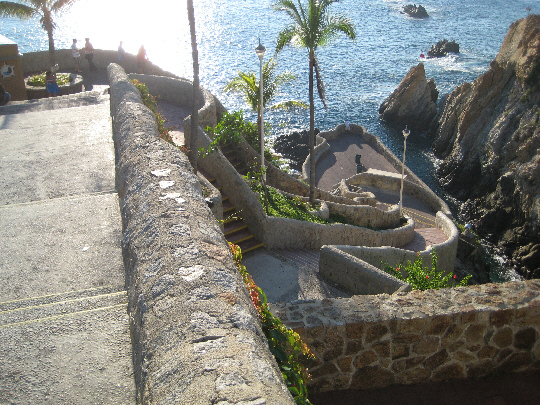
|
The diving began in the 1930s, at least as a scheduled "performance," but diving was probably going on here much earlier than that. Although we didn't get to see it live, we've seen movies and pictures, and the divers do display a graceful finesse as they dive from seemingly suicidal heights into a narrow crevasse, which appears to contain only enough water to wade in. Not surprisingly, the divers pray at a small shrine before flinging themselves into the void. The bar of the Mirador Hotel has a great view of the diving, and a number of movies have used it as a location.
People can watch the cliff diving from many locations, but the prime spot is a series of viewing platforms connected by steep stairways that pretty much covers the cliff opposite from where the divers launch themselves. When diving is going on, there is an admission to these platforms, but this afternoon we were able to climb up and down them as we cared to. And of course we went from top to bottom and stopped at each platform. At one of them, I got an obliging fellow tourist to take a picture of Fred and myself.
Fred took a number of very good pictures while we were walking around on the stairs and platforms, and if you'll click on the thumbnail images below, you can have a look at some of them:

|
Next to the main series of stairways and platforms there was another curious section of inclined walkways and stairs. We couldn't quite figure out what these were used for. From most places on them, there weren't good views of the cliff diving, although there were some very pretty views up the coast. They wrapped around the plaza and then connected up with the walkway along the highway. It seemed like a lot of effort had been put into them.

|
|
I made a movie from the lowest viewing platform looking first up at El Mirador and then panning down the ravine into which the divers plunge, ending up with a view to the shrine on the opposite cliff face. |
The stairway to the main viewing area went down the crest of one promontory, and on the other side was another ravine. Perhaps the purpose of the other walkways was to allow viewing into this ravine. Again, there was an inlet here, but this time the water came in the narrow channel and went under the cliff. Only a movie can show this.
|
In this movie you can see the water in the narrow inlet on the other side of the viewing platform, and how it has eaten its way underneath the rock cliff face. |
Along the Cantilevered Highway and Walk
While Fred was admiring the view and taking some pictures, I saw a way to continue beyond the paved path and get down underneath the highway, where I thought I might get some good views. I did not know that Fred took a picture of me underneath the roadway where I thought I might get some good views. I did, as it turned out, get a great view looking up the coast to the north.
|
From my vantage point underneath the high, I got a neat view looking north, so I made a movie. You can see Fred in this movie, still back at the actual overlook above me. |
We both came back up the stairs from that overlook. At this point, we were just below the plaza, right at the point where the street came out of a tunnel and started on out to the end of the point. We started along the walkway in that direction, admiring the views. I got a bit ahead of Fred, as I usually do, so I appear in his picture looking down the walkway. I stopped to wait for him about where you just saw me, and he came on along, taking pictures looking down at the sea, looking up the coast and looking back up at El Mirador. Meanwhile, I was trying my own hand at a telephoto shot (my zoom is not nearly so good as Fred's) of some people on the cliff diving viewing platform.
|
Waiting for Fred to catch up with me, I made a movie looking back up the walkway, and taking in the scenery around the point where I was standing. |
We continued down the walkway together, admiring the views.
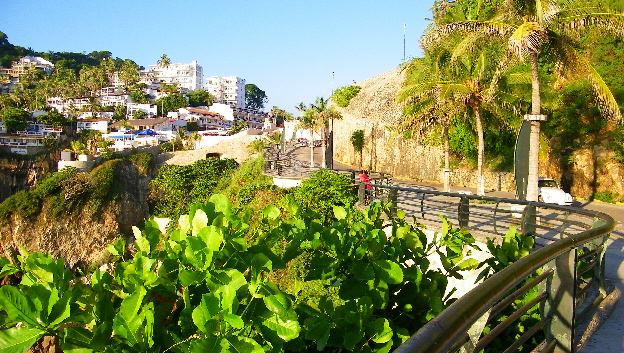 Looking Back Up the Walkway Towards El Mirador |

|
From this point we could see that ahead of us the walkway's overlooks ended beyond the next one, and so we continued walking to get to that last overlook. (It would have been interesting to walk all the way around the point, but at the time I had no idea how far that might be, so we eschewed that possibility and settled for the last overlook.)
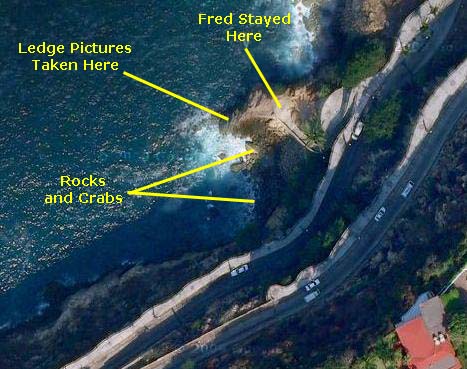
|
Anyway, there was a rock wall around the plaza, with a notch in one side of it so that you could look through and see the El Mirador and the cliff diving site. I suppose this was done so kids could see without climbing up on the wall itself, but I can't be sure. Beyond the wall in that direction there was a pretty steep drop-off down to the rocky shore.
|
From the small plaza at the overlook, Fred made a pretty good movie looking up at the cantilevered highways above, and down to the rocky shore below. |
When you are looking through the notch, you are looking northeastward. A little further around to the west, to the left of the notch, there was a wall of bare rock that you can see in the earlier pictures. This rock rose higher than the constructed wall, but was not quite so high that an adult couldn't see over it and look at the shoreline. From Fred's movie above, you can see that below the overlook on the seaward side was a rocky beach strewn with large boulders. The Pacific Ocean waves continually crashed on these rocks. To me, that rocky beach looked very inviting, so, liking to clamber around on rocks the way I do, I thought I would go down there. I couldn't convince Fred to join me, so I left him on the plaza. But it was only twenty feet or so down to the rocks, so I was never out of his sight.
To get down there, I first had to climb up on the bare rock that formed part of the overlook wall. From my vantage point there, about ten feet above the floor of the overlook, I got some excellent views looking up the coast and down at the rocky shoreline.
|
Holding on to the crevices in the rock with one hand, I made my own movie looking all around. You'll see the waves crashing on the shore, and look beyond the El Mirador up the coast. Interestingly, Fred took a picture of me while I was filming this movie, and you should look at that picture here. |
|
It wasn't difficult to get down to the rocks; it was much like bouldering at Mt. Scott in the Wichita Mountains, except that the rocks were much smaller. But I was careful, and got down in one piece.
While I was on my way down, Fred had noticed the crabs crawling all over the wet rocks down at the waterline. I had seen them also, and thought I'd take some pictures of them when I got closer. I did show them eventually in one movie, but Fred, with his really neat zoom lens, captured a better picture of the crabs from all the way up on the plaza than I did when I got down to the rocks.
|
Unbekownst to me, while I was making my way down to the "beach" Fred was filming my progress, and the movie turned out well. When I got down there and started taking my own pictures, Fred took another picture of me that you can see here. |
So I got down to the boulders in one piece and just walked around for a bit admiring the view and listening to the sounds of the waves on the rocks.

|
|
I took one major movie down here, and it shows the boulders and waves, the coastline and the view back up to the overlook where you can see Fred waiting for me. |
I took a pretty good picture looking back up at Fred on the overlook above, and you can have a look at that picture here. But we couldn't stay here much longer, so in a little while I started back up to rejoin Fred.
|
Fred made his own movie of the rocky beach from up at the overlook. I didn't know it at the time, but his movie also includes my entire trip back up the rock face to rejoin him. A really neat movie. |
Well, we've had a great walk and seen some spectacular scenery, but now it's almost six o'clock and time to head back to the ship. We headed back up the walkway along the road to the tunnel. Now, with the afternoon light streaming into it, we could actually see the inside of the tunnel for the first time, and found that there was a huge, fantastical, colorful mural painted all along the inside wall between the traffic lanes. It was really an amazing mural, and Fred thought it worth taking pictures of. He took four pictures covering it from end to end as we walked through. Click on the thumbnails below and you will be able to see the entire mural:

|
From the tunnel at the crest of the hill, we took a different street back down to the harbor. Along the way, there were a couple of interesting street scenes, and you can have a look at them here and here.

|

|
On Board the Oosterdam (Nighttime)

|
|
While Fred was taking his nighttime pictures, I made a movie of the area by the ship, including the Fort and Avenue Aleman. |
At 9PM, there was a pool party at the Lido Pool amidships. It was basically a dessert buffet, but there was music and dancing as well. We just wandered around through it for a while, sampling some of the desserts.
|
From my vantage point up on the Observation Deck, here is what the Lido Pool Party looked and sounded like. |
As I said, the pool party included a dessert buffet, and they did it up nicely. One of the features of the party were the two... well, you should just have a look (kudos to the unwitting star of my film). |
Right at about ten thirty, the ship began to move away slowly from the dock on its way out of the harbor. Fred took a couple of good nighttime pictures when we were just a short distance out into the harbor, and you can have a look at those pictures here and here. Then we just stayed at the rail watching nighttime Acapulco fade off into the distance as we headed out for our overnight cruise up the coast to Zihuatanejo, Mexico.
You can use the links below to continue to the album page for different day.
 |
November 17, 2009: Zihuatanejo, Mexico |
 |
November 15, 2009: Hualtulco, Mexico |
 |
Return to the Index for Our Panama Canal Cruise |